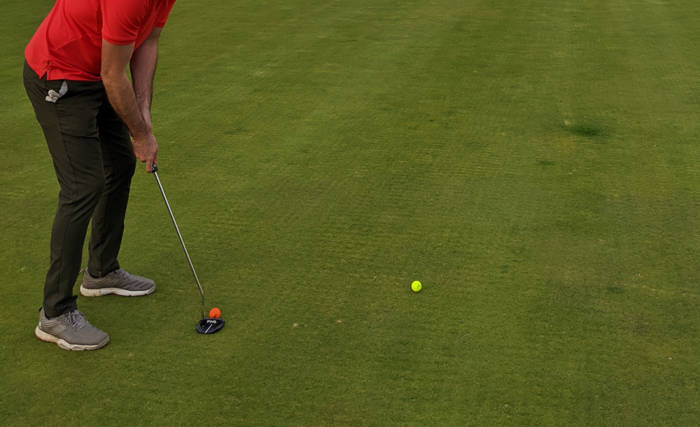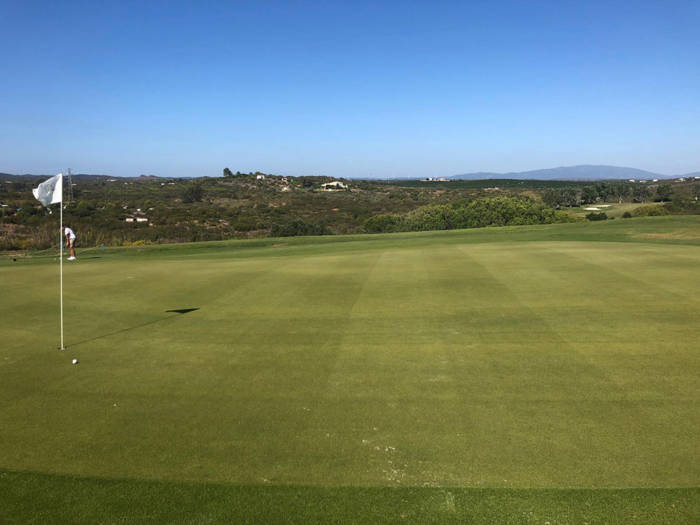What is Hollow Tining?
We have all been there. We show up for our weekend tee time, excited to play only to discover the greens have been hollow tined.

Naturally our first reaction is to get frustrated because we know it will be harder to sink putts. But as golfers, in the long term we should be happy that the greenkeepers have done this as it’s a pretty critical task in maintaining the greens.
What is hollow tining?
Hollow tining is a method used by greenkeepers at golf courses to aerate the greens.
There are a number of different terms used to describe this activity. You may have heard your golf mates say “the greens have been punched” or aerated. They are all correct and pretty much mean the same thing.
It’s performed by inserting a round tube into the ground (or green) and removing a “core” of turf. The holes left in the green are usually around 13mm – 16mm wide.
Once the entire green has been punched / cored (hollow tined) the greenskeeper will drag off the chunks of turf and top dress with some sand.
Why do greens get hollow tined?
If hollow tining greens irritates the customers (golfers) why do golf courses do it?
The process of hollow tining or aerating the green is critical to the long-term health of the putting surfaces.
Think about where you go when you play golf. Some golfers end up in the fairway, while others end up in the rough or woods, but all players eventually walk on the green.
This concentrated traffic on the putting surfaces causes the ground to become compacted and hardened. In turn, this leads to poor drainage and less oxygen for the roots of the grass. Hollow tining is the best way to treat this.
Punching holes in the green allows the turf to expand, receive more oxygen, and more easily absorb moisture. In other words, heal and live longer!

The frustrating part for golfers is that this process will change a perfect putting surface into an unpredictable and bumpy green. Some players may even avoid playing courses that have recently hollow tined their greens. If you are bothered by bumpy greens you may want to ask the pro shop before you book a tee time.
But bear in mind that the work causes a short term problem but ensures longer term health for the greens.
Can you play on hollow tined greens?
You can absolutely play on hollow tined greens, but you may not love it.
The key is approaching your round with the correct mindset. Recently hollow tined greens can be bumpy and inconsistent, so you can’t expect every putt to roll perfectly. You’re bound to get the odd bad bounce.
But of course, you could also get a lucky bounce – sometimes on hollow tined greens bad putts go in!
A good mantra for putting on hollow tined greens is “control what you can control”. You can’t control the odd bounce, but you can get the speed correct. Make sure you hit aggressive putts, with plenty of pace. All you can do is make a good putting stroke – the golfing gods control the rest.
Another oddity about putting on hollow tined greens is they typically putt slightly better immediately following the treatment than a couple weeks later. Following green aeration, most courses will water them heavily and mow them less. This means that if you play them two weeks after your greens have been hollow tined you could find them to be both slow and bumpy.

What if you sign-up for a tournament and the greens have recently been “punched”?
From a rules perspective nothing changes. Unfortunately, you can’t take relief from a hollow tine hole or move your ball to try to avoid putting over one.
The one exception would be if the tournament committee puts in a local rule. Our advice would be to read the rules of the competition closely or ask before heading to the 1st tee.
Why do greenkeepers put sand on the greens?
The process of putting a thin layer of sand on the greens is known as “top dressing” and it is done to improve the quality of turf. Typically greenskeepers will top dress the greens after hollow tining them to complete the process.
The sand typically fills up some of the holes made whilst aerating the greens which helps with drainage, and improves the overall quality of your putting surface.
The layer of sand will often help your greens recover more quickly from the hollow tining – again short term pain for long term gain!
A quick tip if you play on greens that have been top dressed:
Always take a moment to clean your golf ball and the face of your putter prior to hitting the ball. Sand on either surface can cause you to miss a putt. Even a tap-in can be missed, so keep your ball and putter face clean.
How often are greens hollow tined and sanded (top dressed)?
All golf courses will hollow tine and sand their greens, but the frequency will vary depending on the type of terrain and putting surface (Bermuda, Bent, Poa Annua).
In general, golf courses will hollow tine their greens once or twice a year, typically in the spring and / or Autumn.
Greens will also be top dressed with sand at least that often, but may be done more often depending on how the greens are looking.
The age of your greens will also have a big impact on how often they are treated. Older greens tend to get compacted quicker and will require more action to keep them healthy.
You may also notice other treatments on the greens from time to time.
Verti-cutting or slicing is common in the summer months to help the putting surfaces breath. You will notice small slits throughout the green. This is a quicker procedure than hollow tining and has less impact on the golfers trying to putt.
Conclusion
As golfers we would always prefer to putt on smooth and quick greens – you know, like Augusta National.
Unfortunately, in order to provide high quality putting surfaces for the majority of the year, greenskeepers have to inconvenience us for a few weeks here and there.
The worst thing that can happen is that your favorite course decides to skip these critical treatments and they start losing the greens. To put it another way, if your greens die, you really don’t have a golf course anymore.
The next time you show up to play and the greens have been hollow tined, be thankful that you’re playing at a course that takes the long-term health of the club seriously. Make the best stroke you can and laugh when your ball gets a bad bounce and lips out.
Control what you can control and enjoy your day!